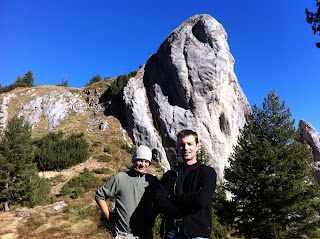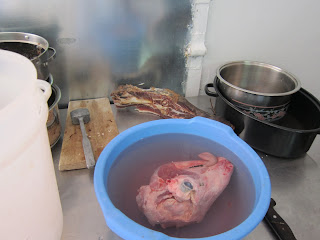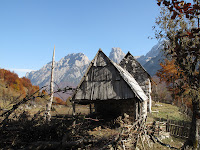Last Monday was a religious holiday, creating a three-day weekend and the perfect opportunity to see a different part of the country. My friends J. and L. kndly invited me to accompany them on a trip to the end of the road, in this case a small mountain settlement called Valbona. None of us knew what to expect except from others' reports that the road was passable, there was a place to stay in Valbona, and the hiking was good.
Heading north and east out of Tirana, we passed through countryside that alternated between picturesque agricultural fields and the largely abandoned remains of industrial activity from communist times. Many of the settlements included tidy little houses right next to large concrete communist-era apartment blocks. It was hard for me to tell which structures were empty and which occupied.
 |
| Reservoir at Kukes |

Soon the sun gave way to fog created by a large reservoir next to the town of "new" Kukes. "Old" Kukes was buried under water when the reservoir was created.
After another few hours and a quick trip on newly made roads across the Kosovo border, the scenery became more pastoral. Rocky peaks began to appear on the horizon.
 |
| The road to Bjram Curri |
The road was good and traffic was light.
Arriving at the town of Bjram Curri in the early afternoon, we stopped for a perfectly adequate pizza lunch at the local hotel. The place was bustling with many tables occupied by local people out for an afternoon coffee and a cigarette (in the smaller towns the ban on indoor smoking is either unknown or unenforced). But despite the smoky haze, the place had great energy with everyone visiting and socializing.
Right out of Bjram Curri the pavement ended and we began bumping our way along a steep gravel road right beside the river channel heading up to the higher elevations.
 |
| Goats on the white gravel road |
The local rock, which is plentiful, is mostly bright white (dolomite?). The effect of the rock in the late afternoon light was luminous, reminding this Alaskan of a snow-covered road next to a mountain tributary.
 |
| A fellow traveler |
 |
| Gorge next to the road |
 |
| Cabin (next to bldng w/more rooms) |
Finally the road ended at the small settlement of Valbona. Although I was told that as many as 8000 people lived in this area during communist times, with winter just around the corner it seemed largely uninhabited. Luckily, the inn was open. Heaters were quickly fetched for our cabins, which had electricity and running water (cold only). That night we had dinner in the main building and watched a bad American movie on the jumbo flat-screen TV. Although I was a little surprised to see the TV in that rustic setting, the people who live there seemed happy to have the diversion.
The next day we were up early for our hike, which featured spectacular vistas in full fall color.
We had heard of a trail going over a pass into the village of Theth, roughly six miles distant. We were delighted to learn that just the day before, two guides from High Albania (
http://www.highalbania.com/) had marked the trail with red-and-white blazes in order to include it in an international inter-Balkan trail system.
After some initial difficulty finding the freshly painted blazes, we easily followed the route, which featured some elevation but no steep grades. Starting at a little settlement a few minutes from our inn, the trail climbed above brush line into uninhabited and beautiful mountainous terrain.
 |
| At the pass |
Roughly three miles on, the little trail delivered me to an easy pass improbably situated amongst the tall and jagged peaks. It then continued down to Theth.
 |
| The pass again |
 |
| Dramatic terrain |
So to sum up my trip report: I highly recommend this area, especially in the fall, and especially now that the trail is blazed.


























































